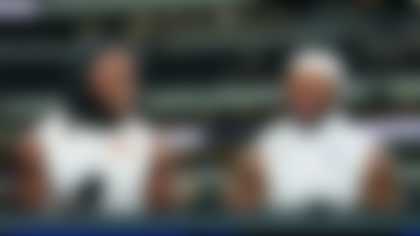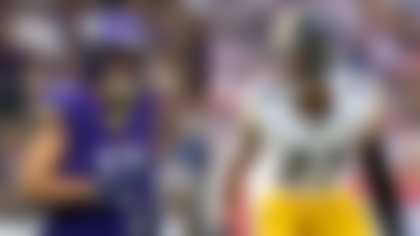By Bill Bradley, contributing editor
Dr. Javier Cardenas is the medical director at the Barrow Concussion and Brain Injury Center in Phoenix. He is quickly becoming one of the most recognizable names in football-related concussion research.
During the past two years, Dr. Cardenas has helped to create a ground-breaking concussion project for high school athletes, recently joined the NFL's Head, Neck and Spine Committee and worked as the sideline independent neurospecialist for the Super Bowl and the Pro Bowl earlier this year.
This week Dr. Cardenas talked with NFL Evolution about the Barrow Institute's concussion research, his involvement with the Heads Up Football program and his experiences at Super Bowl XLIX.
The Barrow Institute has been at the forefront of head injury research in the past few years. What made you focus on football and contact sports?
At Barrow Neurological Institute, our program -- the Barrow Concussion and Brain Injury Center -- focuses on all types of injuries to the brain, whether it's a sports-related injury or an accident or someone falling off a horse. Our perspective is actually from a brain-injury view. When it comes to sports-related activities, part of that is out of the research that we've done and the experience we have in treating people who suffered concussions from playing football and other sports.
How many college and pro teams do you currently work with?
When it comes to pro teams, I work as an unaffiliated neurotrauma consultant -- meaning that I'm on the sidelines -- for all NFL games played in Phoenix. This last year, that was wonderful, and I got to cover the Pro Bowl and the Super Bowl. I also provide coverage for Arizona State University -- both their football and their women's soccer teams.
You gained some notoriety a few years ago with the creation of the Barrow Brain Book, which tracks head injuries of high school athletes. How has that been received?
Barrow Brain Book is the most successful concussion education program that there is in the country. This is something that was a collaborative effort between the Arizona Cardinals, the Arizona Interscholastic Association and Barrow Neurological Institute. We decided to focus our education on the individual that is impacted the most and that is the high school athletes. There were other programs that were focused on parents, coaches, teachers and health-care providers. That's all very important, but not directed at the athlete. We have had over a quarter-million athletes complete our education program. And it has spawned a number of other programs as a result, including a concussion-education video game. We also offer free baseline testing for every single Arizona high school athlete. And we also provide a telemedicine program, Skype for Concussions, to all of the athletic trainers in the state. Through this they can get a hold of a concussion specialist wherever they are and whenever there needs to be an issue. … We can be present on the sidelines, in the locker room or in the athlete training room after an injury.
You mentioned the Barrows Brain Ball game to help with diagnoses. How has that helped in dealing with children's concussions?
Brain Ball is designed for the 8 to 12-year-old age group. It was not literally a day after we came out with the Barrow Brain Book did a parent come up to me and say, "This is fantastic for my high schooler but what about my little kid who is in youth sports?" Barrow Brain Ball is focused on that age group. The Cardinals were kind enough to let us use their logo as was the Arizona Super Bowl Host Committee while we were developing it.
You've been involved with the Arizona Cardinals as a speaker since they started their Moms Football Safety Clinics. What got you involved in the related Heads Up Football program?
Wherever there's an opportunity for education, I feel it's important to provide that. I actually come from a background of a former teacher. Before I went into medicine, I was a high school special education teacher. When I was invited to speak to moms, I leapt at the opportunity. I've been doing it now for the last three or four years where we're speaking to parents and athletes about the appropriate steps to take in the event of a concussion, recognizing that this is more common in collision sports like football and hockey and the like. We tell them if you demonstrate a full recovery and don't put yourself in harm's way before you do so, then you can continue to play these games.
What led you to be selected as the independent sideline neurologist for last month's Super Bowl?
I was contacted by the NFL and the organizer for all the Super Bowls. I was approached two years ago because we knew (Super Bowl XLIX) was going to be here. Someone would need to provide the independent coverage on the sidelines. We spent the last year preparing -- both on the sidelines and checking out the logistics around the city -- to make sure that we had appropriate coverage in the event of an injury.
You've been on the sideline for countless football games, but how was the Super Bowl experience different?
It was different in many ways. First and foremost, I was excited and happy to do it. Just being there was a privilege. But I take my job very seriously, so I had no bias whatsoever as far as the teams that were playing. I didn't even care which sideline I was on. Just the energy that was in the stadium was amazing. Logistically, it was a big, more challenging (than a Cardinals game) because there was more media on the sidelines. I partnered with a very kind security guard and stood back-to-back with him so I could have a great view of the field and do my job.
What was just as exciting for me was the Pro Bowl (one week earlier in Glendale, Arizona). The atmosphere was quite different at the Pro Bowl, far more relaxed. Fortunately, there were no injuries. It was a nice game to enjoy. As you saw from the (Super Bowl), we had our work cut out for us. I evaluated about seven athletes on the sidelines. Only one of them (Seattle Seahawks defensive end Cliff Avril) had to come off the field, which most people saw. That was the extent of our (concussion) work.
There was one apparent head injury that gained a lot of attention after the game. Many in the media questioned if New England Patriots wide receiver Julian Edelman suffered a concussion during the fourth quarter. Did he go through concussion protocol after the hit?
I was covering the Seattle sideline. While I can't comment any individual athlete, I can tell you that all protocols were followed as they are written. If there was any question about anybody being evaluated, I can tell you that all athletes were evaluated for possible head injuries.
What are your thoughts on the NFL's decision to allow third-party medical observers to call timeouts in order to pull players who are suspected of injuries off the field?
It is a bold and important move to allow athletic-trainer spotters to call a timeout in order to have an athlete evaluated. On the sidelines, we evaluate every athlete with a potential head injury ASAP. This decision enhances our ability to do so. I don't know of any other sport where a health-care provider can call a timeout. This is huge for the NFL and for the sports medicine community. I hope that other professional and amateur sports organizations will take notice and follow suit. There are tremendous challenges in stopping soccer games, for example, and that is not just for concussion. There are universal applications to this decision.
Now that you have been involved in pro sports for a few years, what are some of the issues we still face with concussions?
The biggest issue that we face is long-term damage. The issue is that we simply don't know if it's multiple injuries, if it's a single injury or if it's an injury that is either undisclosed or undetected, so the sub-concussive injuries are really a question right now. Our current thinking is that once somebody suffers an injury and they completely recover from it, then they should be at no greater risk for any problems in the long term. However, research needs to be done to fully understand that. And we need to make sure that people aren't suffering injuries and we're unaware.
Part of that requires athletes to be forthcoming. I've clearly seen a culture change at the NFL level in which more players are self-reporting. That's great. That's what we want to see at all levels. I see it more at the NFL level than I do in colleges and high school level. We also need to come up with something that's more objective in terms of our diagnosis of concussions. Right now, it's based on physical examination, a history and some tools that we have to help us, but it is not purely objective.
What's next for you, Dr. Cardenas? Do you have any more projects involving the NFL?
There are always projects coming up. With respect to my NFL involvement, I'm honored to serve on the NFL's Head, Neck and Spine Committee. I had my first meeting with them in Indianapolis during the NFL Scouting Combine just last month. There's more research to be done, more protocols.to refine and more work to make sure we've got a handle on this injury. But it's pretty clear that the NFL is taking the lead when it comes to concussion prevention and management.
Photos courtesy Barrow Neurological Institute.



